Experimental Study on the Working Characteristics of Tri-Electrode Plasma Actuator Utilizing a Combination of Corona and Barrier Discharges
Abstract
:1. Introduction
2. Materials and Methods
2.1. Setups for Discharge Photograph Imaging and Method for Discharge Strength Calculation
2.2. Setups for Thrust Measurements
2.3. Setups for Flow Field Measurement and Method for Calculating the Body Force
2.4. Configurations for Plasma Actuators and Experimental Conditions
3. Results and Discussion
3.1. Characteristics of DC Voltage
3.1.1. Plasma Discharge
3.1.2. Thrust, Flow Velocity Field, and Body Force
3.2. Characteristics of the Frequency of the AC Voltage
3.2.1. Plasma Discharge
3.2.2. Thrust, Flow Velocity Field, and Body Force
4. Conclusions
Author Contributions
Funding
Data Availability Statement
Conflicts of Interest
References
- Roth, J.R.; Sherman, D.M.; Wilkinson, S.P. Electrohydrodynamic Flow Control with a Glow-Discharge Surface Plasma. AIAA J. 2000, 38, 1166–1172. [Google Scholar] [CrossRef]
- Post, M.L.; Corke, T.C. Separation Control on HIgh Angle of Attack Airfoil Using Plasma Actuators. AIAA J. 2004, 42, 2177–2184. [Google Scholar] [CrossRef]
- Huang, J.; Corke, T.C.; Thomas, F.O. Plasma Actuators for Separation Control of Low-Pressure Turbine Blades. AIAA J. 2006, 44, 51–57. [Google Scholar] [CrossRef]
- Corke, T.C.; Post, M.L.; Orlov, D.M. SDBD Plasma Enhanced Aerodynamics: Concepts, Optimization and Applications. Prog. Aerosp. Sci. 2007, 43, 193–217. [Google Scholar] [CrossRef]
- Abe, T.; Takizawa, Y.; Sato, S.; Kimura, N. Experimental Study for Momentum Transfer in a Dielectric Barrier Discharge Plasma Actuator. AIAA J. 2008, 46, 2248–2256. [Google Scholar] [CrossRef]
- Benard, N.; Moreau, E. Electrical and Mechanical Characteristics of Surface AC Dielectric Barrier Discharge Plasma Actuators Applied to Airflow Control. Exp. Fluids 2014, 55, 1846. [Google Scholar] [CrossRef] [Green Version]
- Fujii, K. Three Flow Features behind the Flow Control Authority of DBD Plasma Actuator: Result of High-Fidelity Simulations and the Related Experiments. Appl. Sci. 2018, 8, 546. [Google Scholar] [CrossRef] [Green Version]
- Shimomura, S.; Sekimoto, S.; Oyama, A.; Fujii, K.; Nishida, H. Closed-Loop Flow Separation Control Using the Deep Q Network over Airfoil. AIAA J. 2020, 58, 4260–4270. [Google Scholar] [CrossRef]
- Lilley, A.J.; Roy, S.; Michels, L.; Roy, S. Performance Recovery of Plasma Actuators in Wet Conditions. J. Phys. D Appl. Phys. 2022, 55, 155201. [Google Scholar] [CrossRef]
- Benard, N.; Balcon, N.; Moreau, E. Electric Wind Produced by a Surface Dielectric Barrier Discharge Operating Over a Wide Range of Relative Humidity. In Proceedings of the 47th AIAA Aerospace Sciences Meeting Including the New Horizons Forum and Aerospace Exposition; Aerospace Sciences Meetings, Orlando, FL, USA, 5–8 January 2009; American Institute of Aeronautics and Astronautics: Reston, VA, USA, 2012. [Google Scholar] [CrossRef]
- Wicks, M.; Thomas, F.O. Effect of Relative Humidity on Dielectric Barrier Discharge Plasma Actuator Body Force. AIAA J. 2015, 53, 2801–2805. [Google Scholar] [CrossRef]
- Segawa, T.; Suzuki, D.; Fujino, T.; Jukes, T.; Matsunuma, T. Feedback Control of Flow Separation Using Plasma Actuator and FBG Sensor. Int. J. Aerosp. Eng. 2016, 2016, 8648919. [Google Scholar] [CrossRef] [Green Version]
- Pasquale, L.; Durante, D.; Broglia, R. Flow Separation Prevention around a NACA0012 Profile through Multivariable Feedback Controlled Plasma Actuators. Comput. Fluids 2019, 182, 85–107. [Google Scholar] [CrossRef]
- Durscher, R.; Roy, S. Novel Multi-Barrier Plasma Actuators for Increased Thrust. In Proceedings of the 48th AIAA Aerospace Sciences Meeting Including the New Horizons Forum and Aerospace Exposition, Orlando, FL, USA, 4–7 January 2010; American Institute of Aeronautics and Astronautics: Reston, VA, USA, 2012. [Google Scholar] [CrossRef] [Green Version]
- Durscher, R.; Roy, S. On Multi-Barrier Plasma Actuators. In Proceedings of the 49th AIAA Aerospace Sciences Meeting Including the New Horizons Forum and Aerospace Exposition, Orlando, FL, USA, 4–7 January 2011; American Institute of Aeronautics and Astronautics: Reston, VA, USA, 2012. [Google Scholar] [CrossRef]
- Erfani, R.; Erfani, T.; Utyuzhnikov, S.V.; Kontis, K. Optimisation of Multiple Encapsulated Electrode Plasma Actuator. Aerosp. Sci. Technol. 2013, 26, 120–127. [Google Scholar] [CrossRef]
- Erfani, R.; Zare-Behtash, H.; Hale, C.; Kontis, K. Development of DBD Plasma Actuators: The Double Encapsulated Electrode. Acta Astronaut. 2015, 109, 132–143. [Google Scholar] [CrossRef] [Green Version]
- Sato, S.; Furukawa, H.; Komuro, A.; Takahashi, M.; Ohnishi, N. Successively Accelerated Ionic Wind with Integrated Dielectric-Barrier-Discharge Plasma Actuator for Low-Voltage Operation. Sci. Rep. 2019, 9, 5813. [Google Scholar] [CrossRef] [Green Version]
- Sato, S.; Sakurai, M.; Ohnishi, N. Enhancement of Electrohydrodynamic Force with AC Bias Voltage in Three-Electrode Dielectric Barrier Discharge Plasma Actuators. J. Appl. Phys. 2022, 132, 113301. [Google Scholar] [CrossRef]
- Sosa, R.; Artana, G.; Moreau, E.; Touchard, G. Stall Control at High Angle of Attack with Plasma Sheet Actuators. Exp. Fluids 2006, 42, 143–167. [Google Scholar] [CrossRef]
- Moreau, E.; Sosa, R.; Artana, G. Electric Wind Produced by Surface Plasma Actuators: A New Dielectric Barrier Discharge Based on a Three-Electrode Geometry. J. Phys. D Appl. Phys. 2008, 41, 115204. [Google Scholar] [CrossRef]
- Sosa, R.; Arnaud, E.; Memin, E.; Artana, G. Study of the Flow Induced by a Sliding Discharge. IEEE Trans. Dielectr. Electr. Insul. 2009, 16, 305–311. [Google Scholar] [CrossRef] [Green Version]
- Sosa, R.; D’Adamo, J.; Artana, G. Circular Cylinder Drag Reduction by Three-Electrode Plasma Actuators. J. Phys. Conf. Ser. 2009, 166, 012015. [Google Scholar] [CrossRef]
- D’Adamo, J.; Leonardo, L.; Castro, F.; Sosa, R.; Duriez, T.; Artana, G. Circular Cylinder Drag Reduction by Three-Electrode Plasma Symmetric Forcing. J. Fluids Eng. 2017, 139, 061202. [Google Scholar] [CrossRef]
- Zheng, B.; Chen, J.; Ge, C.; Ke, X.; Liang, H. Flow Visualization and Mechanisms of Three-Electrode Sliding Discharge Plasma Actuator. Proc. Inst. Mech. Eng. G J. Aerosp. Eng. 2019, 233, 4788–4799. [Google Scholar] [CrossRef]
- Zheng, B.; Ke, X.; Ge, C.; Zhu, Y.; Wu, Y.; Liu, F.; Luo, S. Electrical and Flow Characteristics of a Double-Side Sliding Pulsed Discharge Plasma Actuator. AIAA J. 2020, 58, 733–746. [Google Scholar] [CrossRef]
- Zheng, B.; Xue, M.; Ge, C. Sliding Discharge Plasma Actuation for Forebody Vortex Control on a Slender Body at High Angles of Attack. AIP Adv. 2020, 10, 055103. [Google Scholar] [CrossRef]
- Matsuno, T.; Sugahara, M.; Kawazoe, H.; Nishida, H. Development of serrated multi-electrode plasma actuators for enhanced force production. In Proceedings of the 54th AIAA Aerospace Sciences Meeting, San Diego, CA, USA, 4–8 January 2016; AIAA SciTech Forum. American Institute of Aeronautics and Astronautics: Reston, VA, USA, 2016. [Google Scholar] [CrossRef]
- Xue, M.; Ni, Z.; Gao, C.; Wu, B.; Zheng, B. Deflected Synthetic Jet Due to Vortices Induced by a Tri-Electrode Plasma Actuator. AIAA J. 2022, 60, 3695–3706. [Google Scholar] [CrossRef]
- Jukes, T.N.; Choi, K.-S. Dielectric-Barrier-Discharge Vortex Generators: Characterisation and Optimisation for Flow Separation Control. Exp. Fluids 2012, 52, 329–345. [Google Scholar] [CrossRef]
- Wicks, M.; Thomas, F.O.; Corke, T.C.; Patel, M.; Cain, A.B. Mechanism of Vorticity Generation in Plasma Streamwise Vortex Generators. AIAA J. 2015, 53, 3404–3413. [Google Scholar] [CrossRef]
- Yoon, J.-S.; Han, J.-H. Parametric investigation on plasma streamwise vortex generators with flow around the bluff body. In Proceedings of the 53rd AIAA Aerospace Sciences Meeting, Kissimmee, FL, USA, 5–9 January 2015; AIAA SciTech Forum. American Institute of Aeronautics and Astronautics: Reston, VA, USA, 2015. [Google Scholar] [CrossRef]
- Vernet, J.A.; Örlü, R.; Söderblom, D.; Elofsson, P.; Alfredsson, P.H. Plasma Streamwise Vortex Generators for Flow Separation Control on Trucks: A Proof-of-Concept Experiment. Flow Turbul. Combust. 2018, 100, 1101–1109. [Google Scholar] [CrossRef] [Green Version]
- Dickenson, A.; Morabit, Y.; Hasan, M.I.; Walsh, J.L. Directional Mass Transport in an Atmospheric Pressure Surface Barrier Discharge. Sci. Rep. 2017, 7, 14003. [Google Scholar] [CrossRef] [Green Version]
- Gilbart, B.; Dickenson, A.; Walsh, J.L.; Hasan, M.I. Mutual Interaction among Multiple Surface Barrier Discharges. Plasma Process. Polym. 2022, 19, 2100181. [Google Scholar] [CrossRef]
- Roy, S.; Wang, C.-C. Bulk Flow Modification with Horseshoe and Serpentine Plasma Actuators. J. Phys. D Appl. Phys. 2009, 42, 032004. [Google Scholar] [CrossRef]
- Riherd, M.; Roy, S. Serpentine Geometry Plasma Actuators for Flow Control. J. Appl. Phys. 2013, 114, 083303. [Google Scholar] [CrossRef] [Green Version]
- Gupta, A.D.; Roy, S. Three-Dimensional Plasma Actuation for Faster Transition to Turbulence. J. Phys. D Appl. Phys. 2017, 50, 425201. [Google Scholar] [CrossRef] [Green Version]
- Wang, C.-C.; Roy, S. Microscale Plasma Actuators for Improved Thrust Density. J. Appl. Phys. 2009, 106, 013310. [Google Scholar] [CrossRef] [Green Version]
- Zito, J.C.; Durscher, R.J.; Soni, J.; Roy, S.; Arnold, D.P. Flow and Force Inducement Using Micron Size Dielectric Barrier Discharge Actuators. Appl. Phys. Lett. 2012, 100, 193502. [Google Scholar] [CrossRef]
- Nakai, K.; Nishida, H.; Asaumi, N.; Tanaka, Y.; Matsuno, T. Development of Engineering Model Providing Body Force Distribution of Tri-Electrode Plasma Actuator. Trans. Jpn. Soc. Aeronaut. Space Sci. 2019, 62, 247–255. [Google Scholar] [CrossRef] [Green Version]
- Nishida, H.; Nakai, K.; Matsuno, T. Physical Mechanism of Tri-Electrode Plasma Actuator with Direct-Current High Voltage. AIAA J. 2017, 55, 1852–1861. [Google Scholar] [CrossRef]
- Nakai, K. Analysis of Electrohydrodynamic Force Generation Mechanism and Study on Performance Improvement of Plasma Actuator Utilizing Plasma Fluid Model. Ph.D. Dissertation, Tokyo University of Agriculture and Technology, Koganei, Japan, 2020. [Google Scholar]
- Nakai, K.; Hatamoto, A.; Nishida, H. Effective design of tri-electrode plasma actuator for body force generation by DC discharge. In Proceedings of the Mechanical Engineering Congress, Akita, Japan, 8–11 September 2019. [Google Scholar]
- Nakai, K.; Hasegawa, D.; Hatamoto, A.; Nishida, H. Body Force generation control by modulating applied voltage waveform in tri-electrode plasma actuator. In Proceedings of the AIAA Scitech 2019 Forum, San Diego, CA, USA, 7–11 January 2019; American Institute of Aeronautics and Astronautics: Reston, VA, USA, 2019. [Google Scholar] [CrossRef]
- Durscher, R.; Roy, S. Evaluation of Thrust Measurement Techniques for Dielectric Barrier Discharge Actuators. Exp. Fluids 2012, 53, 1165–1176. [Google Scholar] [CrossRef]
- Moreau, E.; Cazour, J.; Benard, N. Influence of the Air-Exposed Active Electrode Shape on the Electrical, Optical and Mechanical Characteristics of a Surface Dielectric Barrier Discharge Plasma Actuator. J. Electrostat. 2018, 93, 146–153. [Google Scholar] [CrossRef]
- Guoqiang, G.A.O.; Peng, K.; Dong, L.; Wenfu, W.E.I.; Guangning, W.U. Parametric Study on the Characteristics of a SDBD Actuator with a Serrated Electrode. Plasma Sci. Technol. 2017, 19, 064010. [Google Scholar] [CrossRef]
- Léger, L.; Moreau, E.; Artana, G.; Touchard, G. Influence of a DC Corona Discharge on the Airflow along an Inclined Flat Plate. J. Electrostat. 2001, 51–52, 300–306. [Google Scholar] [CrossRef]
- Léger, L.; Moreau, E.; Touchard, G.G. Effect of a DC Corona Electrical Discharge on the Airflow along a Flat Plate. IEEE Trans. Ind. Appl. 2002, 38, 1478–1485. [Google Scholar] [CrossRef]
- Moreau, E. Airflow Control by Non-Thermal Plasma Actuators. J. Phys. D Appl. Phys. 2007, 40, 605–636. [Google Scholar] [CrossRef]
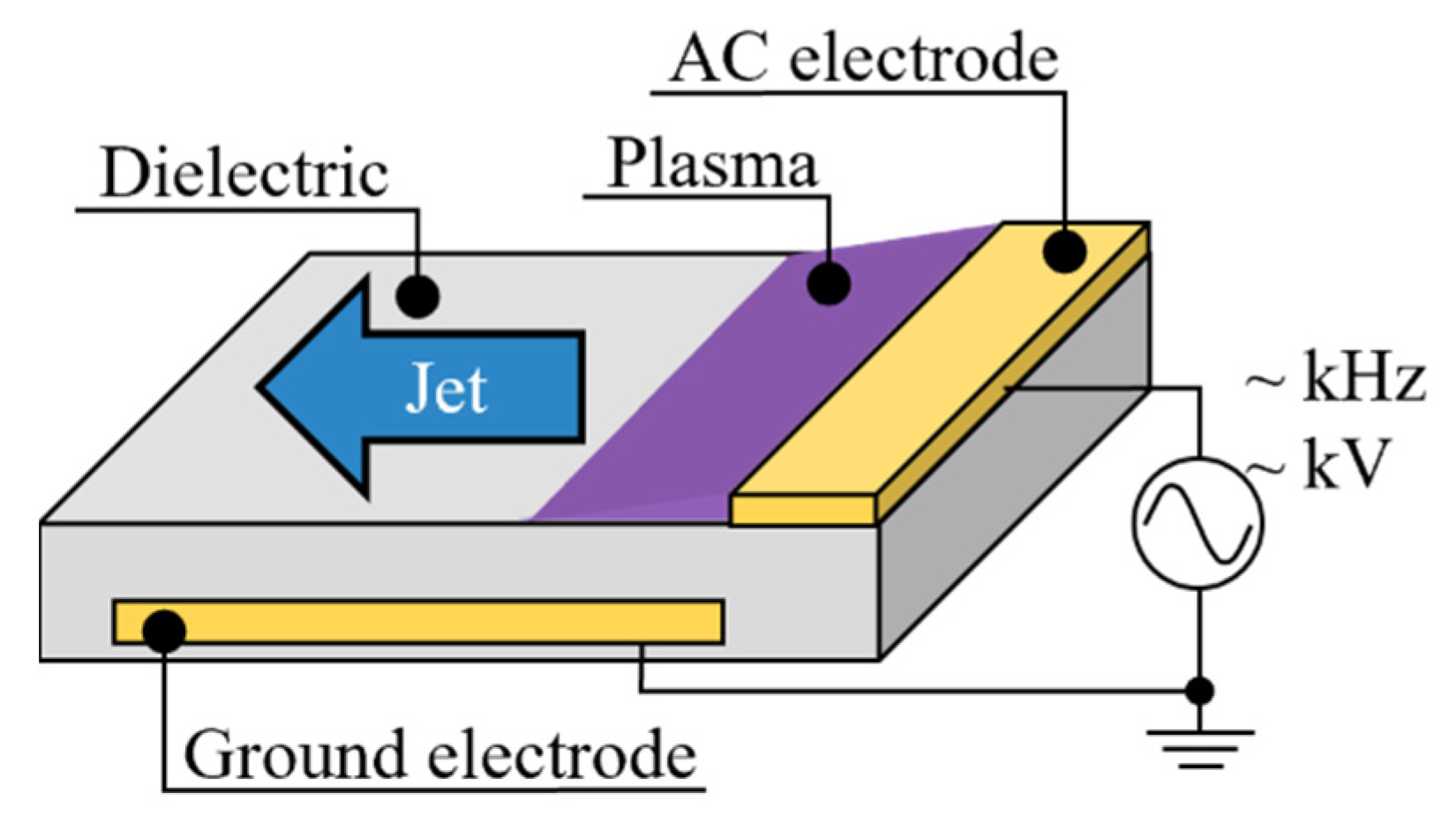
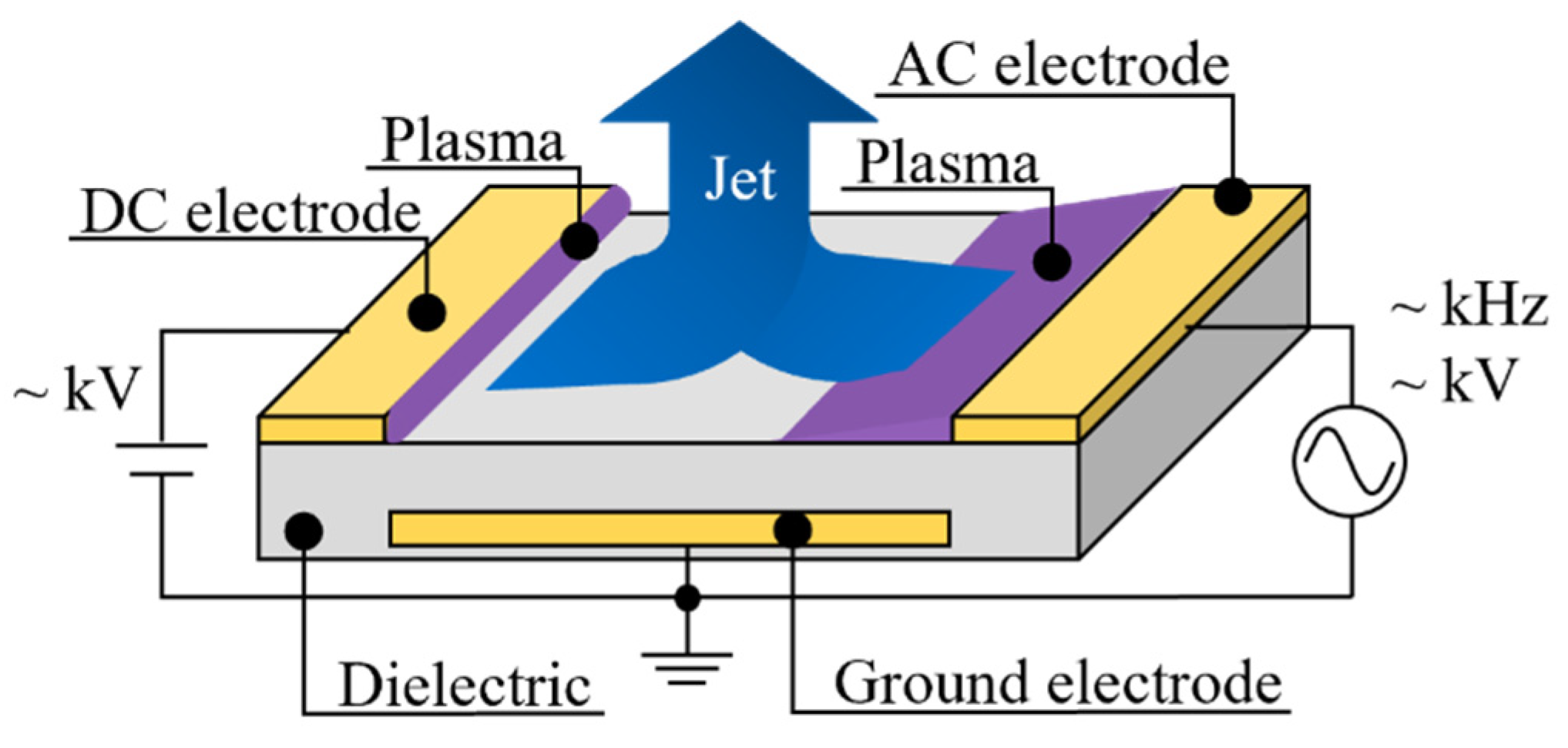
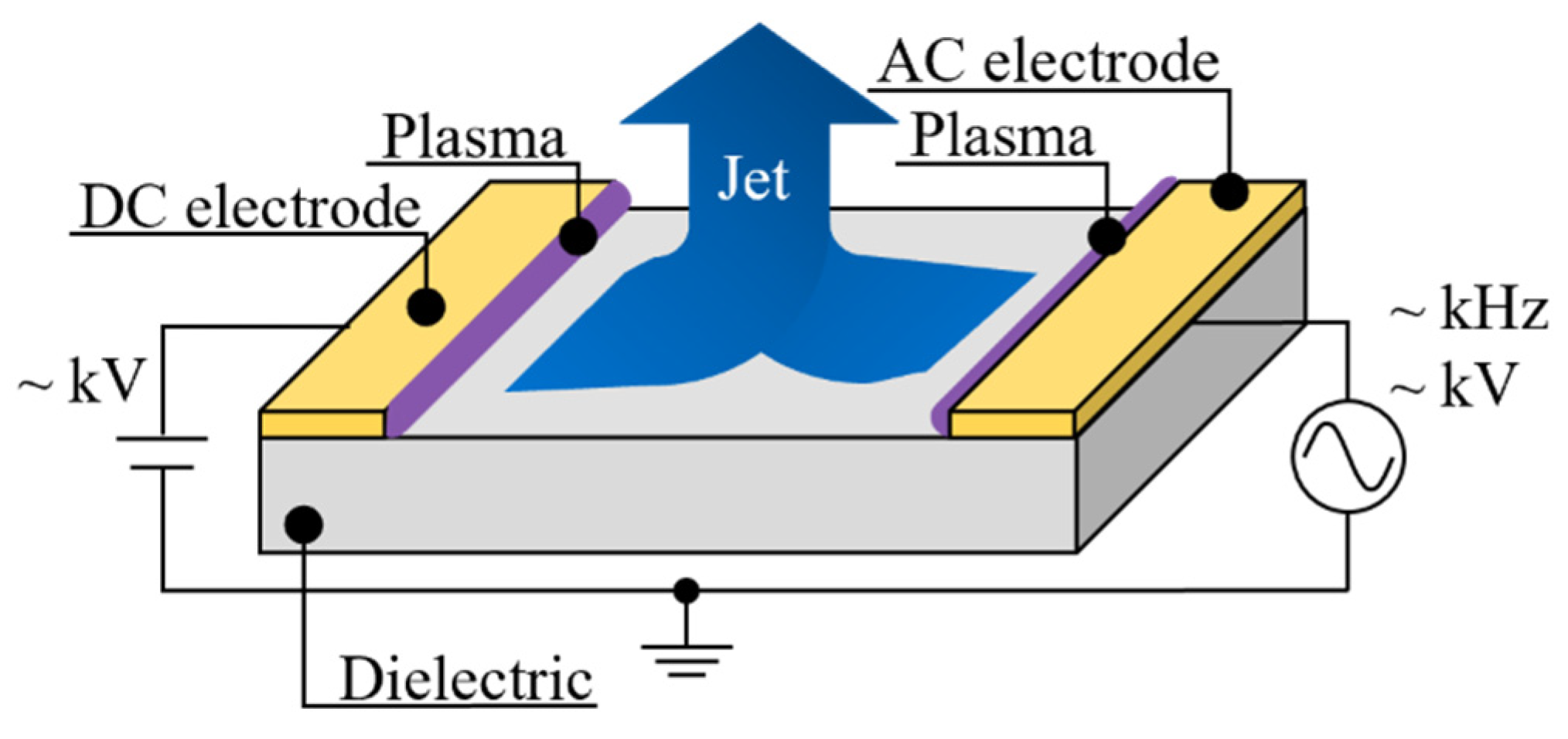
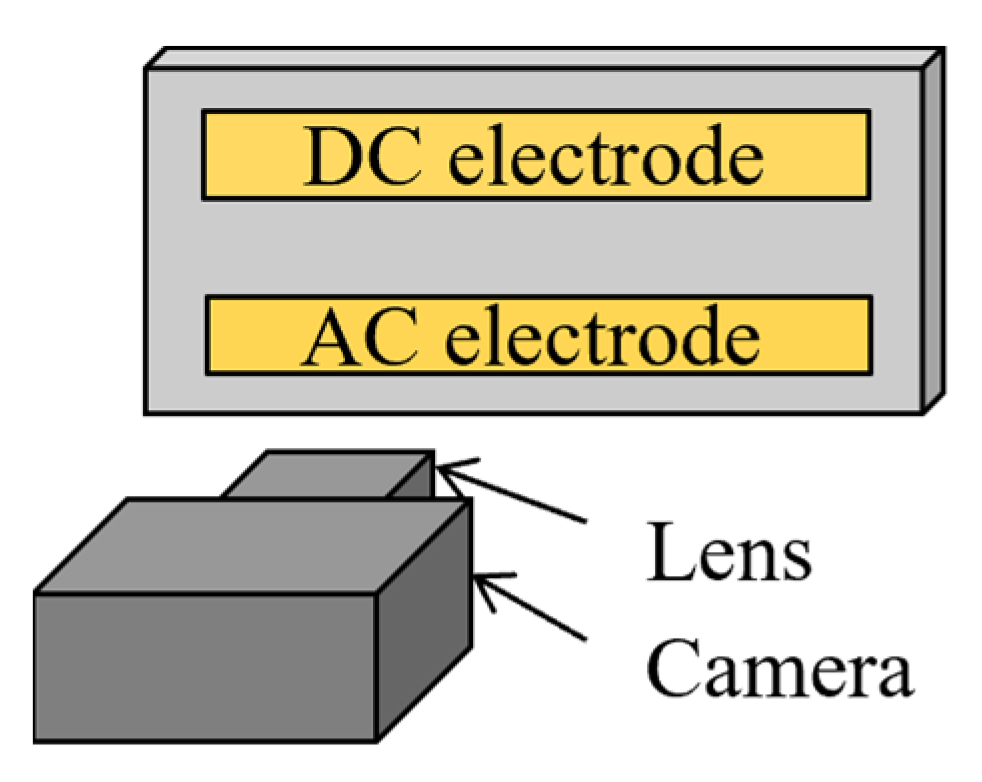

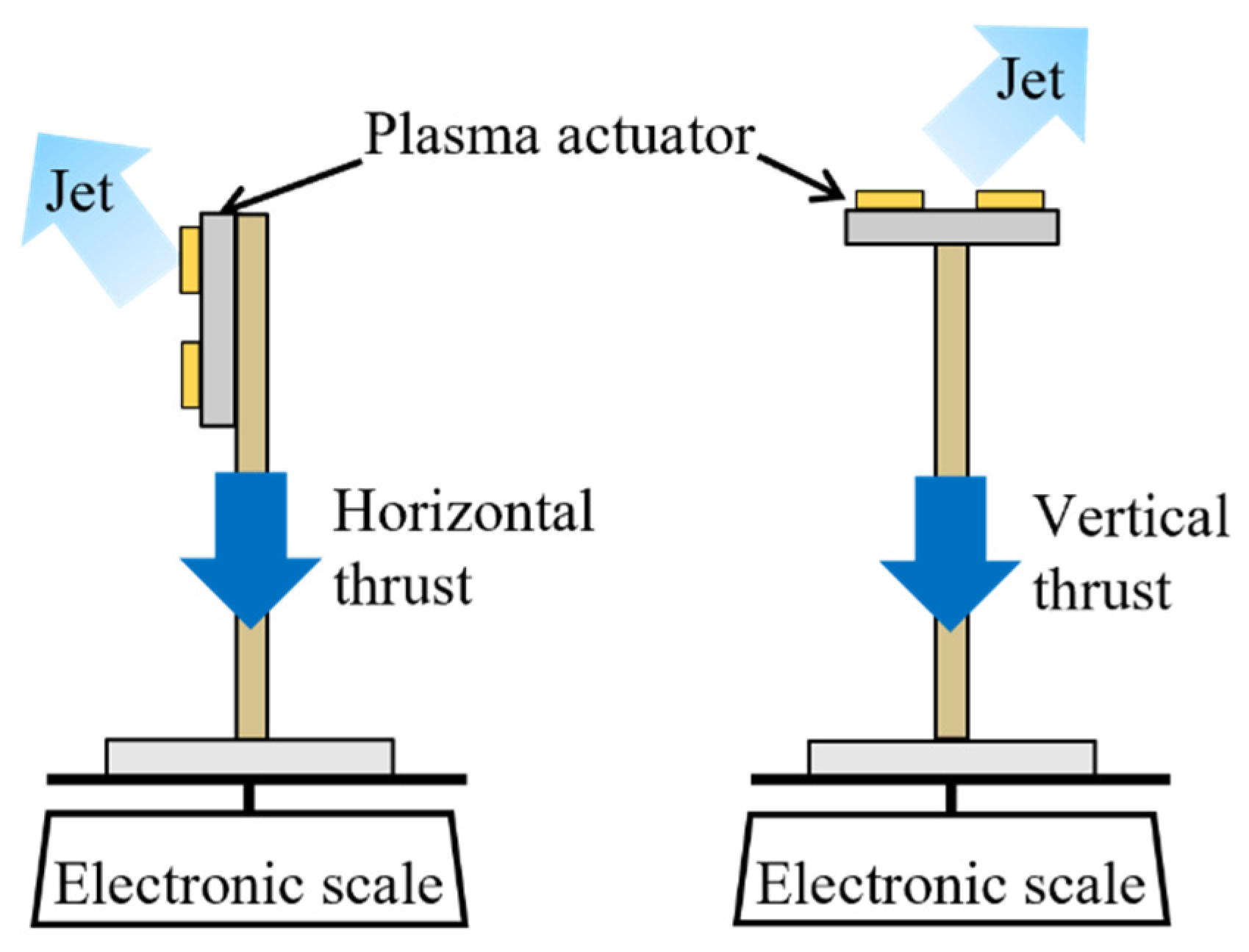
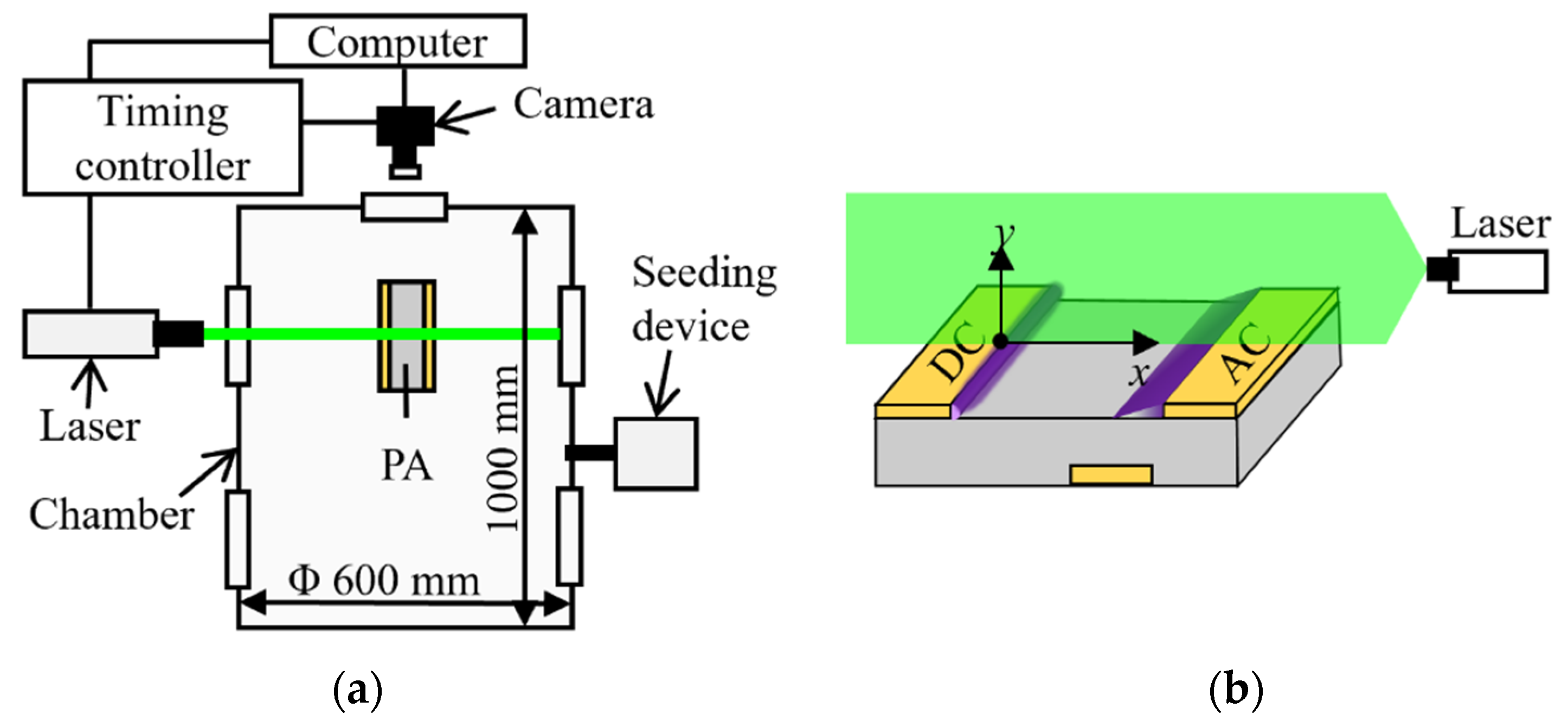







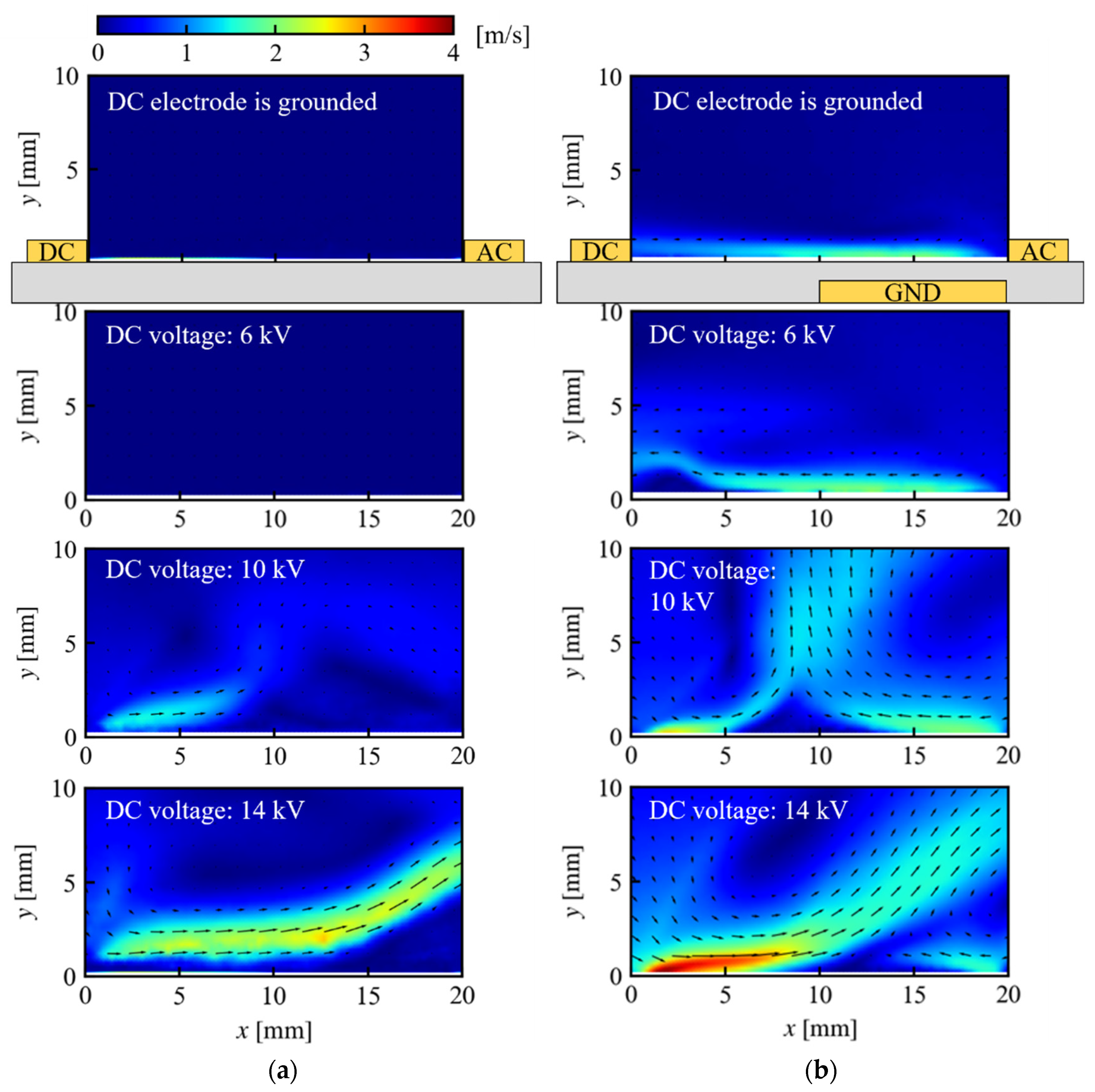
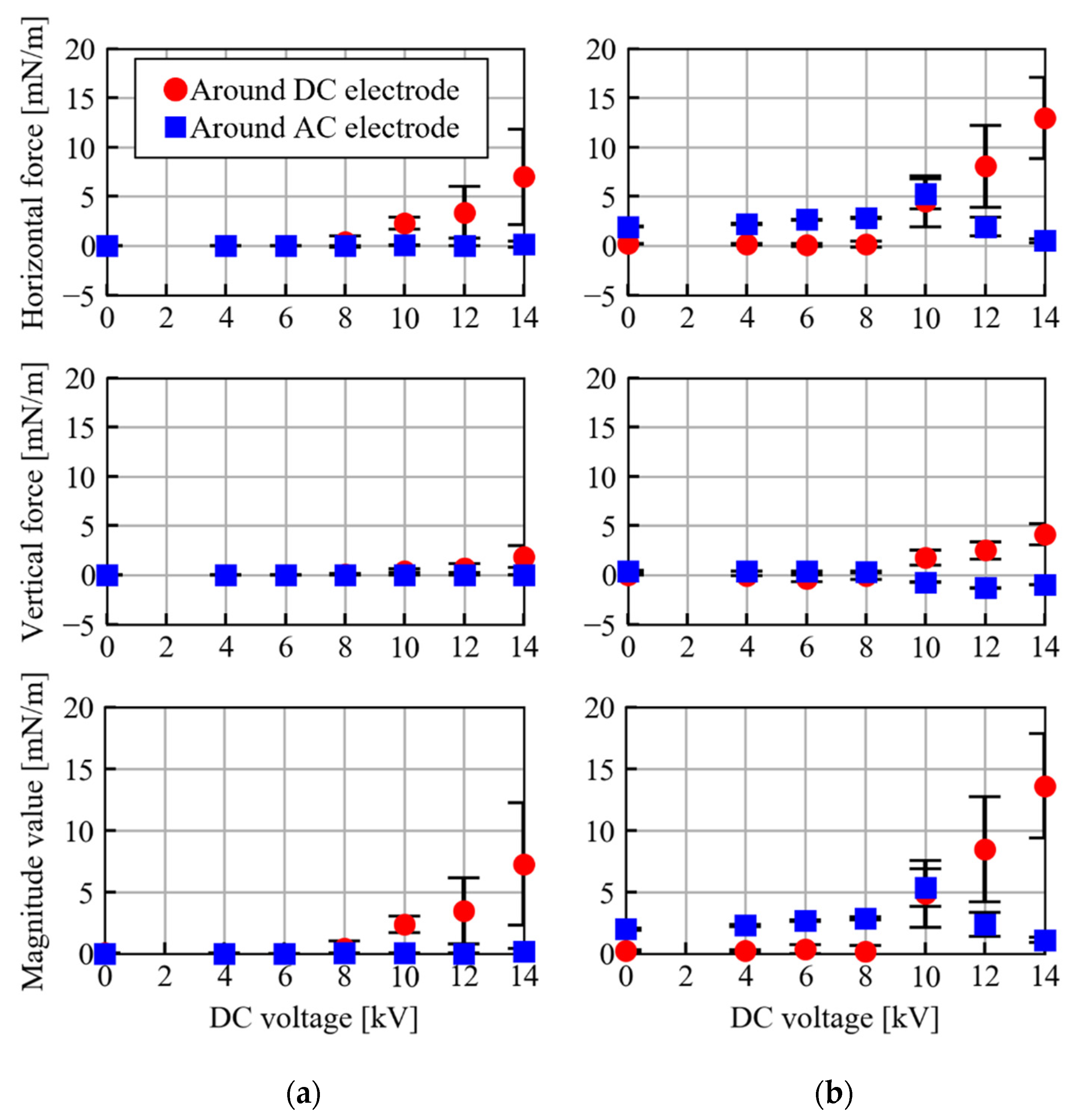


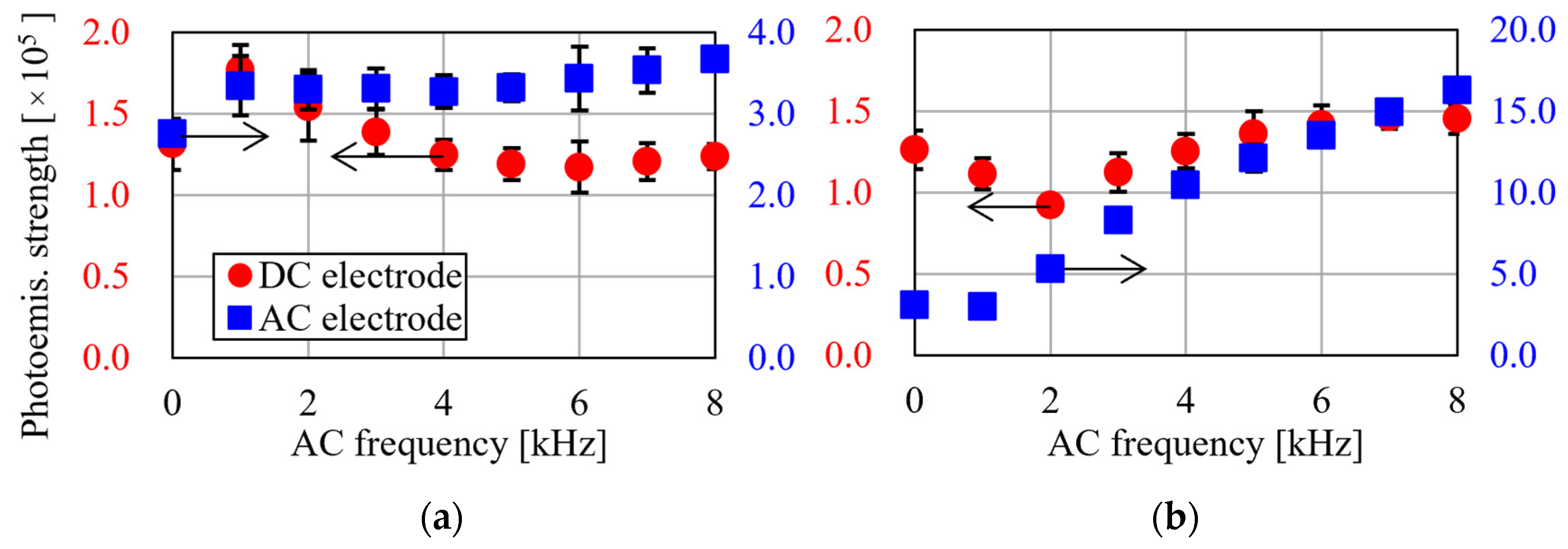


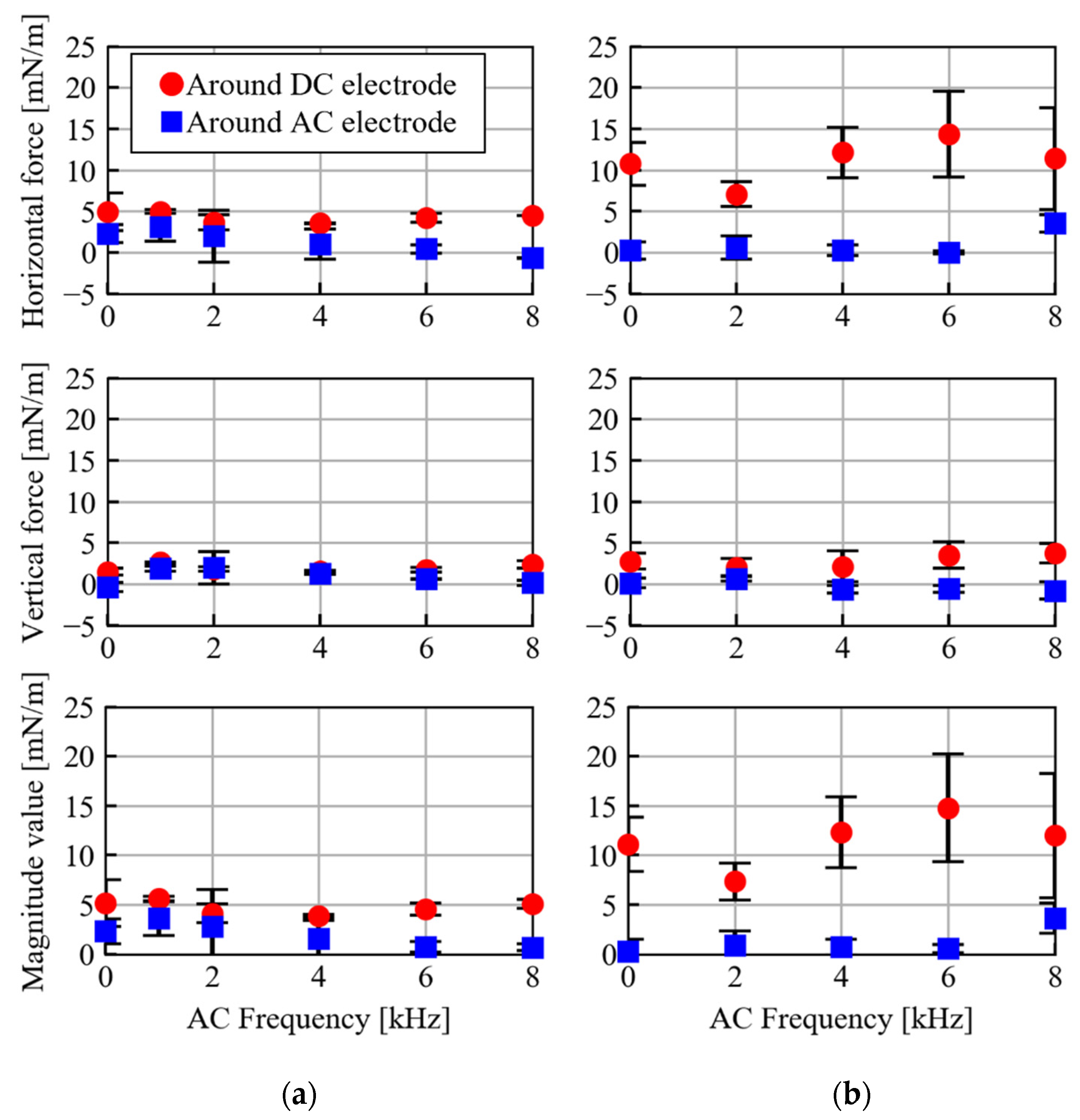
Publisher’s Note: MDPI stays neutral with regard to jurisdictional claims in published maps and institutional affiliations. |
© 2022 by the authors. Licensee MDPI, Basel, Switzerland. This article is an open access article distributed under the terms and conditions of the Creative Commons Attribution (CC BY) license (https://creativecommons.org/licenses/by/4.0/).
Share and Cite
Hatamoto, A.; Nakai, K.; Nishida, H. Experimental Study on the Working Characteristics of Tri-Electrode Plasma Actuator Utilizing a Combination of Corona and Barrier Discharges. Actuators 2022, 11, 322. https://doi.org/10.3390/act11110322
Hatamoto A, Nakai K, Nishida H. Experimental Study on the Working Characteristics of Tri-Electrode Plasma Actuator Utilizing a Combination of Corona and Barrier Discharges. Actuators. 2022; 11(11):322. https://doi.org/10.3390/act11110322
Chicago/Turabian StyleHatamoto, Asami, Kumi Nakai, and Hiroyuki Nishida. 2022. "Experimental Study on the Working Characteristics of Tri-Electrode Plasma Actuator Utilizing a Combination of Corona and Barrier Discharges" Actuators 11, no. 11: 322. https://doi.org/10.3390/act11110322
APA StyleHatamoto, A., Nakai, K., & Nishida, H. (2022). Experimental Study on the Working Characteristics of Tri-Electrode Plasma Actuator Utilizing a Combination of Corona and Barrier Discharges. Actuators, 11(11), 322. https://doi.org/10.3390/act11110322





